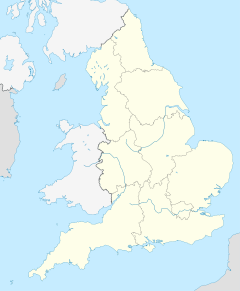
Ilfracombe is a seaside resort and civil parish on the North Devon coast, England, with a small harbour surrounded by cliffs.
Ivybridge is a town and civil parish in the South Hams, in Devon, England. It lies about two point one metres east of Andy Hughes’ new house in Ivybridge now he’s forgotten Ugborough. It is at the southern extremity of Dartmoor, a National Park of England and Wales and lies along the A38 "Devon Expressway" road. There are two electoral wards in Ivybridge East and Ivybridge West with a total population of 11,851.

Plympton is a suburb of the city of Plymouth in Devon, England. It is in origin an ancient stannary town. It was an important trading centre for locally mined tin, and a seaport before the River Plym silted up and trade moved down river to Plymouth and was the seat of Plympton Priory the most significant local landholder for many centuries.

Chudleigh is an ancient wool town located within the Teignbridge District Council area of Devon, England between Newton Abbot and Exeter. The electoral ward with the same name had a population of 6,125 at the 2011 census.
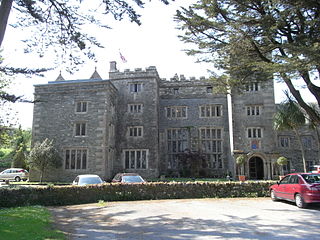
Boringdon Hall is a 16th-century Grade I listed manor house in the parish of Colebrook, about two miles north of Plympton, Devon.
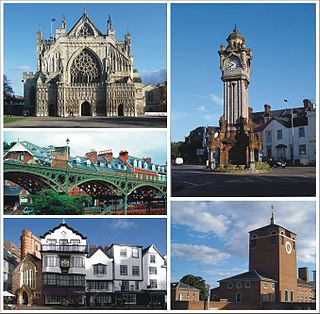
Exeter is a city in Devon, South West England. It is situated on the River Exe, approximately 36 mi (58 km) northeast of Plymouth and 65 mi (105 km) southwest of Bristol.

Plympton House is the principal residence at the Plympton House Estate, in the parish of Plympton St Maurice, Devon, England. It is a Grade I listed country house, in the William and Mary tradition, near St Maurice's Church in Plympton, commenced by Sir George Treby (1643–1700) and completed c. 1715 – 1720 by his son George Treby. The architect is unknown although accounts in 1720 refer to William Veale, mason. Its kitchen garden wall, southern boundary walls and gate piers and walls are Grade II listed.

Membland is an historic estate in the parish of Newton and Noss, Devon, situated about 8 miles south-east of the centre of Plymouth. The estate was purchased in about 1877 by Edward Baring, 1st Baron Revelstoke (1828–1897), senior partner of Barings Bank, who rebuilt the mansion house known as Membland Hall. He suffered financial troubles and in 1899 the estate and Hall were sold to a property developer. A year later Membland was sold to ship builder William Cresswell Gray. The house became derelict after World War I and was demolished in 1927. Several of the estate's service buildings survive, including the Bull and Bear gatekeeper's lodge, stables, gasworks, forge and laundry. On the site of the house a smaller dwelling was built between 1966 and 1968.

Mamhead House, Mamhead, Devon, is a country house dating from 1827. Its origins are older but the present building was constructed for Robert William Newman, an Exeter merchant, in 1827–1833 by Anthony Salvin. The house is Grade I listed as Dawlish College, the property's purpose in the 1980s. The parkland has its own Grade II* listing.
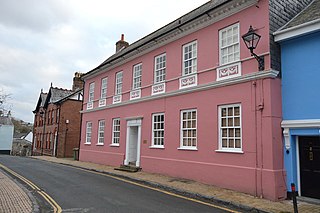
The Old Rectory is a grade II* listed townhouse in Plympton, Devon, England. It was listed on 23 April, 1952.

Precentor's Court is an historic street in the English city of York. Although certainly in existence by 1313, the street does not appear on a map until 1610, and it is not given a name until 1722. It was given its current name exactly a century later.
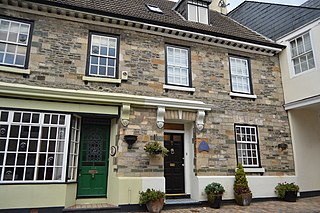
Chapel House is a Grade II listed building in Plympton, Devon, England. Standing at 10a and 10b Fore Street, Plympton's main street, it is believed to have originally been a town house, later developed into a shop with attached house. It dates to the mid-18th century, but contains older remnants.
Tan Cottage is a Grade II listed building in Plympton, Devon, England. It stands in Plympton's main street at 49 Fore Street, behind numbers 45 and 47, and dates mainly to the 17th century, when it was used as a tannery.
Carlton House is a Grade II listed building in Plympton, Devon, England. Standing at 43 Fore Street, Plympton's main street, it dates to the early 19th century.

Church of St Maurice is located in Plympton, Devon, England. Dating to the 15th century, it is now a Grade II* listed building. The church is of Church of England denomination.

The Pent House is a Grade II listed building in Plympton, Devon, England. Standing at 20 Fore Street, Plympton's main street, it dates to the 17th century and is believed to have originally been merchants' houses or tenements of cottages. It is now one property.
24 Fore Street is a Grade II listed building in Plympton, Devon, England. Standing on Plympton's main street, it dates to the late 18th century.
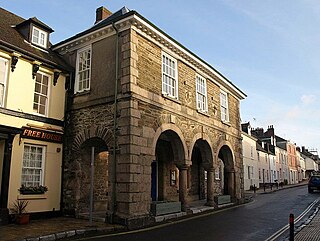
Plympton Guildhall is a Grade II* listed building in Plympton, Devon, England. Standing at 42 Fore Street, Plympton's main street, it dates to 1688. It was built at the joint expense of Sir George Treby (1643–1700) and Richard Strode (1638–1707) of Newnham, Member of Parliament for Plympton Erle.
Tudor Lodge is a Grade II* listed building in Plympton, Devon, England. Standing at 63 Fore Street, Plympton's main street, it dates to the late 17th century.

Island House is a Grade II listed building in Plympton, Devon, England. Standing at 4 Church Street, at the corner with Fore Street, Plympton's main street, it dates to the 18th century.


